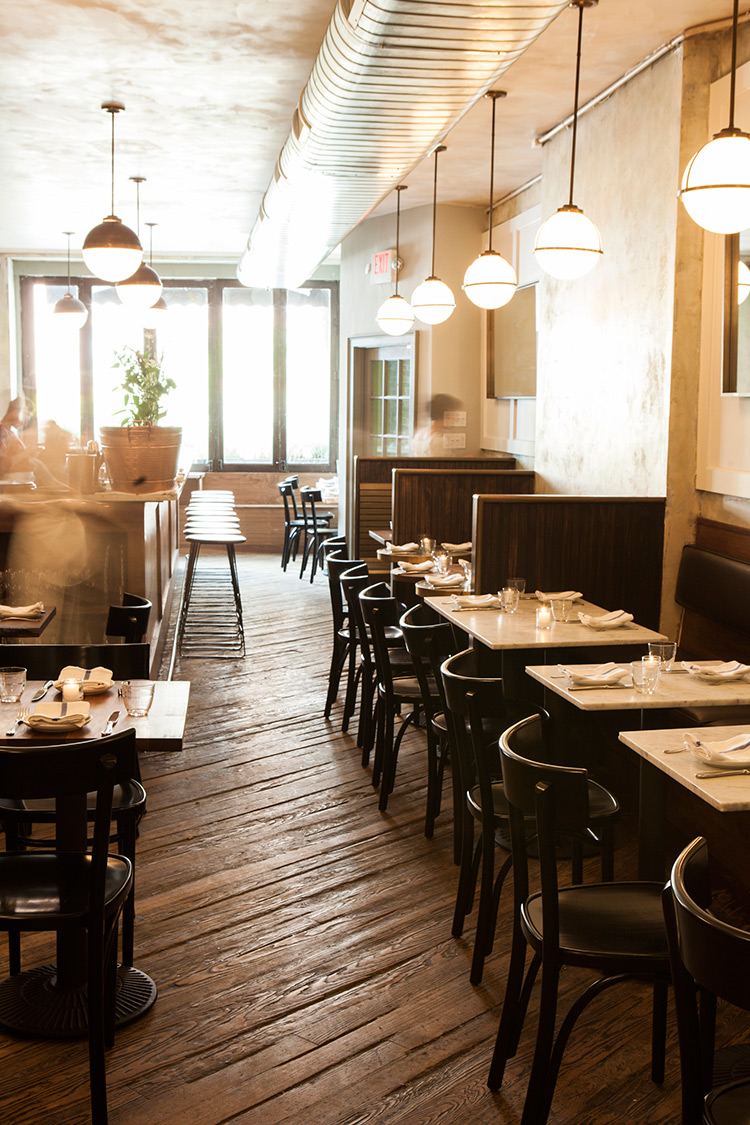Enduro
 Monday, September 23, 2013 at 01:46PM
Monday, September 23, 2013 at 01:46PM 
Note: Enduro did not endure. As of August 2014, the space is BV’s Grill, owned by the same people.
*
 Welcome to Enduro, a handsome new West Midtown spot owned by the heir to the Junior’s restaurant chain.
Welcome to Enduro, a handsome new West Midtown spot owned by the heir to the Junior’s restaurant chain.
The name won’t mean very much to the rest of us: the owner’s grandfather ran a string of “Enduro” restaurants in the 1920s. It’s also a type of off-road motorcycle racing, in case you were wondering. But the owners get plenty of mileage out of the name. On the corridor leading to the restrooms, there’s a bunch of fake ads for fictitious products called “Enduro.”
 They dropped some coin to build this place, spending $7 million to renovate a former Outback Steakhouse. The dining room is spacious and masculine, with heavy wood tables and big horseshoe banquettes, dominated by a large rectangular bar in the center of the room.
They dropped some coin to build this place, spending $7 million to renovate a former Outback Steakhouse. The dining room is spacious and masculine, with heavy wood tables and big horseshoe banquettes, dominated by a large rectangular bar in the center of the room.
Enduro claims to be a classic American grill, a sufficiently malleable description that allows the chef to serve almost anything. On a rotisserie grill, prominently visible in the partially-open kitchen, you’ll find pork loin, chicken, and rotating whole fish specials.
The dinner menu offers snacks ($4–16), salads ($10–24), appetizers ($10–17), mains ($16–49), and side dishes ($8–12). Those are wide ranges. You could get out cheaply with the burger ($16), or not so cheaply with the ribeye steak ($49).
The all-American wine list offers 13 choices by the glass, and 2½ pages’ worth by the bottle, with reds ranging from $40–600, and a decent selection under $60. I didn’t see many bargains, but it was clearly a list with a point of view, and not just the generic stuff that most new restaurants serve.


Pretzel Bread ($4; above left) is baked in shiny round balls, with creamy mustard that delivers a potent kick. Chicken Liver Spread ($8; above right) is a great starter, but it needed to come with twice as much bread. Extra bread came along later, at no charge, but we had to wait for it.


I didn’t taste my companions’ dishes, but there were general nods of approval for Linguini with clams, garlic, and olive oil ($17; above left), and Striped Bass with brown butter and bok choy ($28; above right).


Berkshire Pork Loin off the rotisserie ($24; above left) had a great smoky flavor, but it could have used some crisping at the edges for textual contrast. A side of thick-cut bacon ($8; above right) was a hit at our table; it won’t put Peter Luger out of business, but it’s well worth ordering.
You worry that it could get noisy here, but tables are generously spread out, and the high ceilings dissipate the sound. It was about 80 percent full on a Friday night, with a multi-generational crowd ranging from baby carriages to geriatrics.
Managers and servers seemed to be on top of things in the dining room, but it was a challenge to get a bartender’s attention. There were other minor service lapses: the long wait for a second helping of bread; entrées served with sauces on the side, but no serving spoons.
But the food is good enough for this type of place, the room friendly and welcoming. Enduro is located on the edge of Midtown, where there are plenty of business lunches to be had, with plenty of housing stock to the east, where there’s always demand for a place like this.
Enduro (919 Third Avenue at 56th Street, East Midtown)
Food: American grill standards
Service: Enthusiastic but not yet polished
Ambiance: A large corporate space where you can relax
Rating: ★






















